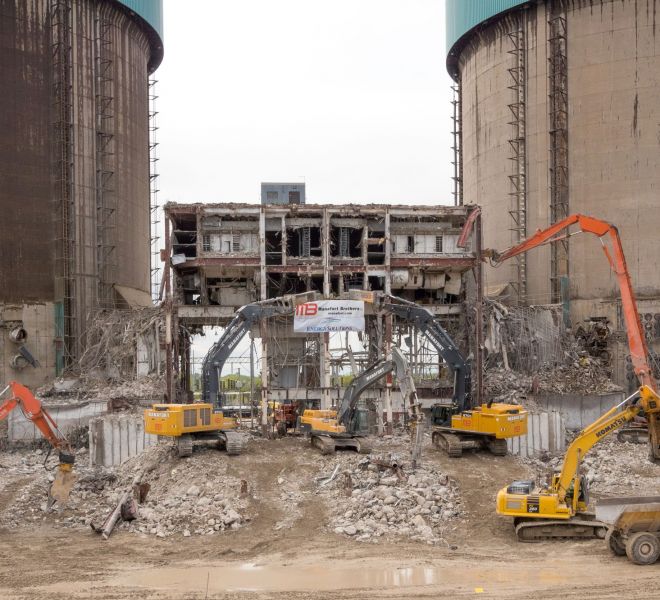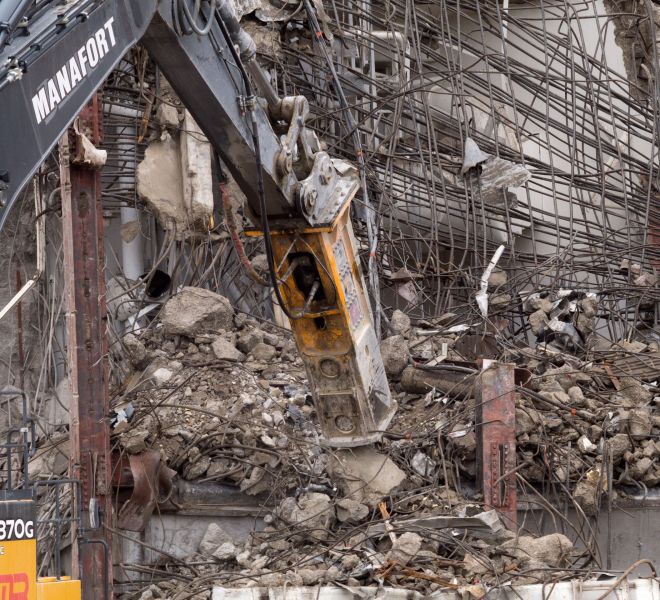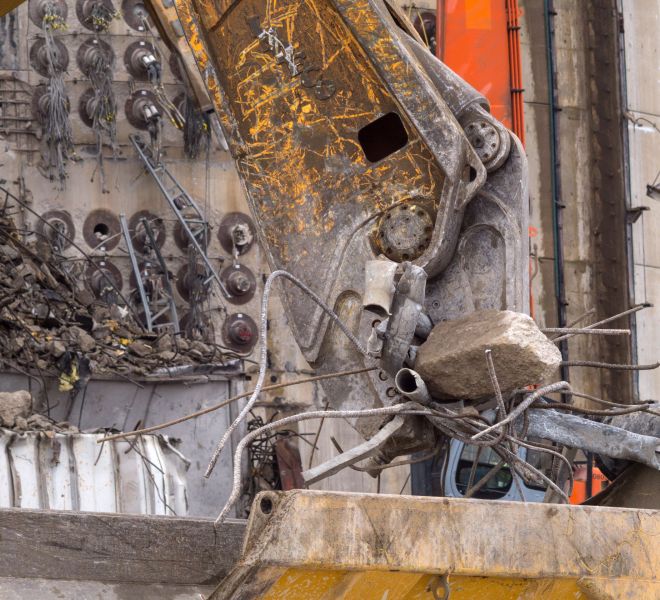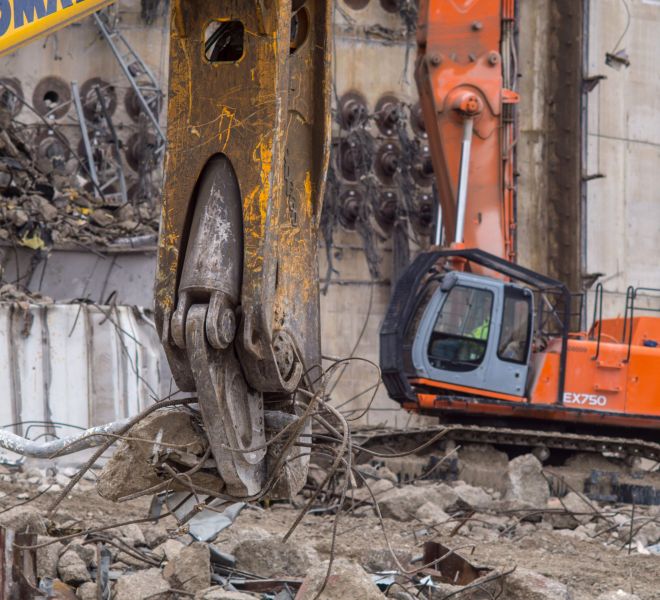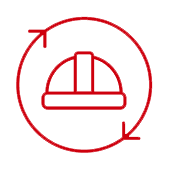“Nuclear” performance in Illinois
Indeco attachments are playing a key role in the demolition of the nuclear power plant in Zion, Illinois. The project is being conducted by Manafort Brothers, one of the most important contractors in the United State specialized in nuclear decommissioning.
Indeco attachments are playing a key role in the demolition of the nuclear power plant in Zion, Illinois. The project is being conducted by Manafort Brothers, one of the most important contractors in the United State specialized in nuclear decommissioning.
The Zion nuclear power plant is located in Illinois on the shores of Lake Michigan about 64 km from Chicago and 68 km from Milwaukee. Completed in 1973, the plant started to produce electricity between December 1973 (first reactor) and September 1974 (second reactor).
The Zion power plant was part of the Commonwealth Edison (ComEd) network and was designed to serve the Chicago metropolitan area and that part of the state along the lake. In February 1997, following an error that led to the accidental shutoff of Reactor 1 (an incident that had no consequences affecting safety), production of electricity was suspended. In February 1998, ComEd, who was to invest $435 million to reactivate Reactor 1 and resupply Reactor 2 with new bars (Reactor 2 had been out of operation at the time of the incident), decided to suspend activity permanently, as the investment would not have produced a sufficient return for the company.
To accelerate conversion of the site, in August 2010 the NRC (Nuclear Regulatory Commission), implementing a procedure that had no precedent in its history, allowed ComEd to transfer the license to Energy Solutions, a company specialized in the decommissioning of nuclear power plants and cleanup of industrial sites. By late 2026, the Energy Solutions project aims to restore the entire area to its “greenfield status”, that is, to the environmental conditions and landscape that characterized it 50 years ago before construction of the nuclear plant was started.
A long and complex decommissioning process
Energy Solutions, through the subsidiary Zion Solutions, is responsible for all removal of the plants, for demolition of the structures, as well as for the conveyance of all debris to a site it owns. Decommissioning started in 1998 with removal of the nuclear fuel from the reactors and securing of the uranium bars. In 2011 decontamination and demolition of the actual structures began; starting from that date and also including soil remediation, this process will take about ten years, require 200 specialized workers per year, and have a total project cost estimated at about $1 billion. The decommissioning plan provided that for all phases pertaining to the demolition of the reinforced concrete and steel structures only mechanical demolition could be implemented.
The use of explosives was excluded a priori given the nature of the site and the potential risk of an uncontrolled release of contaminated dust into the air.
To execute the demolition process properly and safely, the project had to be assigned to a contractor with proven experience and expertise, as the work called for dismantling structures of a certain complexity given the structural characteristics of the buildings and the different types of plants and facilities at the site. In 2014, Zion Solutions contracted the works to Manafort Brothers of New Britain, Connecticut, a company with a 100-year old history and a national reputation, since it was and remains the only company that has performed demolition of two nuclear power plants on the East Coast of the U.S.
Manafort Brothers started with the building where the turbines and generator were originally installed, no longer visible now that it is completely demolished, then proceeded with the interior of the two towers that housed Reactor 1 and Reactor 2, where various plants and equipment were removed. This was followed by the dismantling of the large building that housed the auxiliary plants situated between the two towers whose demolition started in autumn 2017.
Besides requiring the experience and the ability to operate safely, demolitions of such difficulty and complexity demand the right machinery and equipment. The long timeframe of the job site, the size and strength of the structures in reinforced concrete and steel, and the need to ensure a sufficient production output, involved a careful evaluation of the equipment used for the demolition.
After their analysis, Manafort Brothers decided to use exclusively Indeco hammers together with a pulverizer and shears, also supplied by Indeco.
A demolition with the Indeco stamp
The hammers being put to work at the Zion site are two HP 25000 (in Europe HP 18000, operating weight: 11,054 kg; tool: 250 mm for 60-140 ton excavators), three HP 13001 (in Europe HP 9000, operating weight: 5000 kg; joule: 15,000; tool: 195 mm for 39-80 ton excavators) and an HP 8000 (in Europe HP 5000, operating weight: 3150 kg; joule: 8000; tool: 160mm for 27-50 ton excavators) mounted on an excavator fitted with a long boom for demolition and, as mentioned, an ISS 30/50 shears and an IRP1250 rotating pulverizer. The attachments are often used contemporaneously, although in different areas of the site; some have been used on an ongoing basis for more than a year. As we were informed by John Carville, site manager for Manafort Brothers: “Here in Zion, as with all demolitions of this kind, there are a whole set of problems to deal with, primarily the health and safety of our workers, the compliance with environmental regulations and the need to properly plan and execute the different stages of demolition so we can access areas not immediately reachable because they are concealed by other structures.
For an idea of how much reinforced concrete is present at the site, let’s just say that by the time we’ve finished the job, we’ll have produced over 113,000 tons of debris, all transported by train to a special site in the desert in Clive, Utah owned by Energy Solutions. And besides the concrete, we have to count the thousands of tons of ferrous and non-ferrous materials that come out of the demolition process.”
That said, the size and scope of the demolition project doesn’t stop with a quantitative breakdown; all the major internal and external structures in reinforced concrete are in cast concrete, varying by location from 1-4 m, with 32-36 mm diameter rebars and a mesh ranging from medium-thick to very thick. We’ve found the biggest thicknesses to be in the structures that go down to almost 18 m below the ground level containing the pumping plants of the cooling water from Lake Michigan, and in the structures that held the reserve of nuclear fuel, and of course the foundations. To take them on, the machines and equipment exert an enormous effort, as emphasized by Carville.
“Manafort Brothers is the only company on the East Coast that boasts specific experience in the demolition of decommissioned nuclear power plants. Before Zion, we did the demolition of the Connecticut Yankee plant at Haddam Neck, Connecticut and the Maine Yankee plant located in Wiscasset, Maine, so we know how to handle these projects, but to be honest, I had never encountered reinforced concrete with a compressive strength of 60-90 MPa (8.7-13 Kpsi) like here in Zion. That’s why the choice of the hammers and the other demolition equipment was absolutely critical. And I also want to point out that the decision for Indeco equipment is based not only on the good experience with the HP 8000 we were already using, but is also the result of a careful comparison with products of the other manufacturers. The two HP 13001 are the models we operate the most, but no surprise it’s the two HP 25000 that allow us to tackle the most challenging situations. The HP 25000, besides benefiting from the Indeco technology contained in all the models of the range, has impressive power, and with its 25,000 joules it is the most productive and powerful hammer on the market today. In certain conditions, it really is the only one that can be a valid alternative to blasting. All the models get top marks for reliability and also durability when it comes to the tools in relation to the type of demolition, a clear sign that the materials used to make them match the level of the materials used for all other components of the hammer. The pulverizer and the shears are delivering excellent productivity too.
The rotating pulverizer has particularly stood out for a favorable ratio between power and size.”
High marks in both production and service
At the Zion site the hammers were and still are subjected to a heavy-duty use over a long-term period. That aspect is not common for normal demolitions, where operations generally last a year or so. In demolitions of large structures the equipment’s production can be measured, but a job like Zion represents a challenge also in terms of service and technical assistance, factors that inevitably end up having a decisive impact on job completion. Emphasizing this particular aspect, John Carville added: “Our satisfaction with the Indeco hammers, the pulverizer and the shears is not only attributed to their production output, but also the service provided by Indeco North America, who has consistently given a rapid and efficient response to all our needs, almost all relating to routine maintenance. It’s no wonder why we intend to order other two HP 13001 to finish up the job.”

